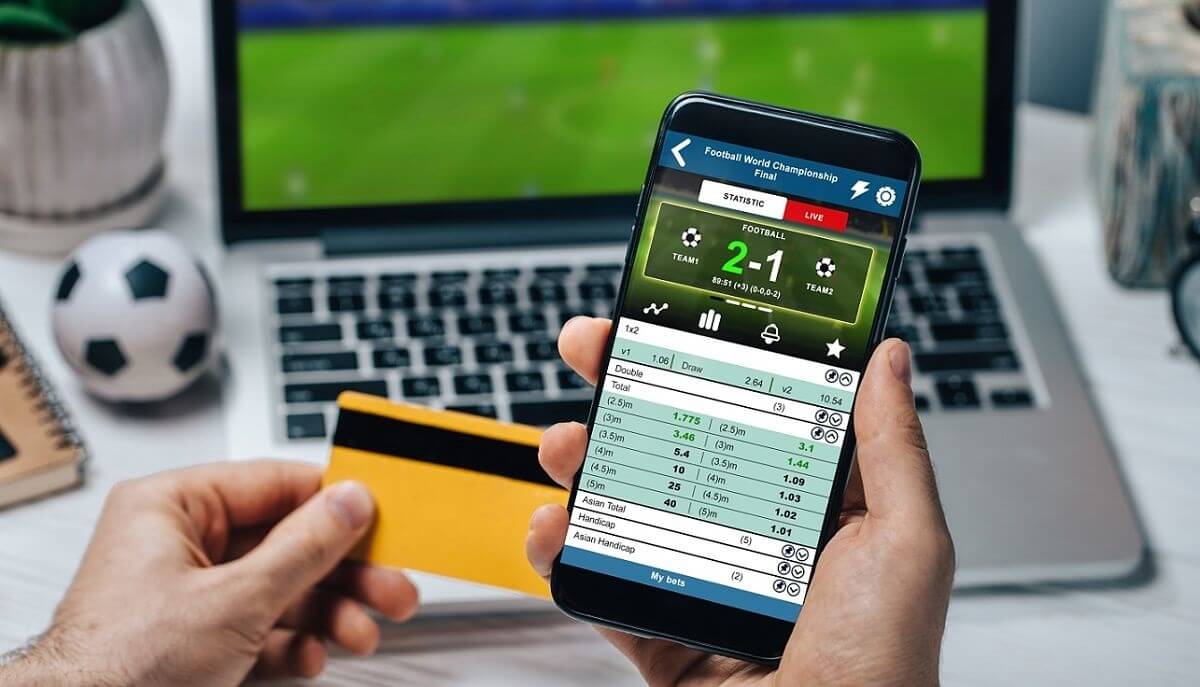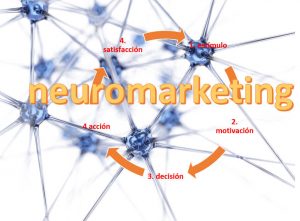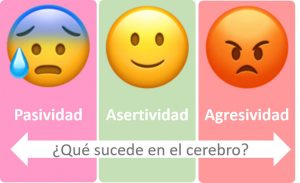Gambling addiction and online betting addictions are serious problems for certain people. NeuroQuotient® helps us understand what happens in the brain in addictions and to identify this risk group and its intensity. It could be used to define user profiles and put filters within online gambling platforms. At the end, we suggest ideas to avoid, minimize, and reverse addiction.
Not long ago we were asked about the possibility of inserting an article in this blog with a link leading to an online gambling and betting website. Nothing is further from our aim!
However, the inquiry prompted us to write this article about how we understand from NeuroQuotient® the brain fundamentals of gambling addiction, in general, and gambling and online betting particularly.
We see with great concern the proliferation of online sports betting houses that also sponsor professional sports. A lot of advertising with great accessibility (who does not have a mobile phone at hand!) implies a great risk. Above all, for certain people.
So, as usually, we are going to explain how we think gambling addiction works in the brain. The main purpose is to help increase awareness of those who may be most at risk of falling into it. Also, from understanding the neuroscience of gambling addiction, we will think of strategies to avoid it and, if possible, reverse it.
Index and how to read faster the article.
The article is quite long. Anyway, if you want to move faster you can do it by following the titles and subtitles throughout it. In addition, the following index links to each section:
– Which people are most at risk?
– Addictions and neurobehaviors in animals.
– How neurobehaviors are generated and more about habits and addictions.
– Behavioral addictions and a prominent feature: Unrealistic expectations.
– NeuroQuotient® helps us detect the risk of gambling addiction.
– People most at risk in NeuroQuotient® and the Temperament and Character Inventory (TCI-R).
– NeuroQuotient® for online sport betting platforms to define profiles and filters?
– Calbet. Only for English version. ?
Which people are most at risk?
The risk is higher in profiles with a high trend in ‘Novelty Seeking’ and a low level in ‘Self-Directedness’ in the ‘Temperament and Character Inventory’ model.
When looking for documentation to support our argument, we found a recent article (2020) by R. Granero et al. Gambling Phenotypes in Online Sports Betting.
They identified the characteristics of the most vulnerable individuals in terms of engaging in online sports betting. They concluded that these people are characterized by being:
“Not married, with low economic status, with high comorbidity with substance addictions, young people, with early involvement in gambling activities, with large debts caused by online sports betting and with a dysfunctional personality profile.”
To determine the personality profile, they used the TCI-R 240 (Temperament and Character Inventory). They found that people most at risk for online gambling addiction stand out for a high score in ‘Novelty Seeking’ and a low score in ‘Self-Directedness’.
When we validated NeuroQuotient® we used the same TCI-R tool from Dr. Robert Cloninger and found remarkable differences within the ‘Novelty Seeking’ subscales. We were interested in knowing if their results were similar. That the reason why we contacted Susana Jiménez-Murcia, one of the authors and head of the Gambling Pathology Unit of the Department of Psychiatry of the Bellvitge University Hospital. On the same day, Dr. Roser Granero (Department of Psychobiology and Methodology of the Autonomous University of Barcelona) gave them to us.
We are very grateful for their kindness. We will return to these results later, they are very interesting!
What is an addiction? Addictions and neurobehaviors.
An addiction is a behavioral pattern in which the reward system is involved and that brings bad results in the medium and long term.
From our point of view, an addiction is an impulsive neurobehavior that is hardly avoidable, despite the bad results it brings in the medium and long term.
In a previous article (relationship between memory and behavior) we defined neurobehavior as a program or pattern of behavior intended, in principle, to favor the survival of the species. We distinguished two types of neurobehaviors: those that guide behaviors that are rewarded with pleasure and those aimed at minimizing harm or pain. The first have to do with the reward system and the others with the threat system.
In Fig 1, we can see a diagram of neurobehaviors in animals from this article.
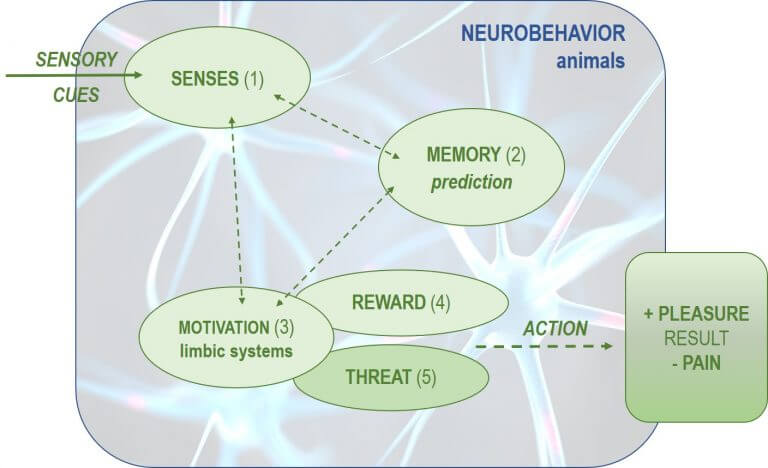
Addictions are behavioral patterns of behavior that have to do with the reward and pleasure system. We are going to review with an example the elements that constitute it:
Let’s imagine a dog that is exploring its territory and that, with its senses (smell, sight,…), it perceives a bone. In the dog’s brain, its species memory will tell it that it is a reward signal. Then the limbic reward system will motivate action and the dog will eat the bone. Finally, after eating the bone, the result for the dog will be pleasant.
Thus, the stages of a neuro-behavior motivated by the reward system are:
sensory cue> limbic approach motivation> action> result
But, it is very important to keep in mind the following: What happens if we deceive the dog and put a poisoned bone within reach? Well, it happens that the dog will also eat the bone. The first three steps will not change, but the result will not be exactly pleasant.
What about humans?
Humans can activate neurobehavior with an imagined or remembered sensory cue, and sometimes we are self-delusional. We are looking for a pleasant result and we may run into unwanted problems.
The differential brain feature of humans is the prefrontal cortex (PFC). The CPF gives us the ability to think and explore the territory with greater intentionality than animals. And something else: our brain does not distinguish between perceived sensory cues from those that we generate with imagination and / or memory. That is, we can activate a neurobehavior only with thought!
This is great for self-motivation, but it can also be bad as we sometimes self-deceive. We can poison ourselves. Perhaps not immediately, but in the medium term. For example, having a couple of glasses of wine provides a good immediate result, we feel a pleasant sensation. However, if we become addicted to alcohol, the result is an unwanted problem.
Addictions are thus neurobehaviors that do not bring good results.
En la Fig2 In Fig2 we reproduce a diagram of neurobehaviors in humans. Bear in mind, however, that addictions involve the reward system and not the threat system.
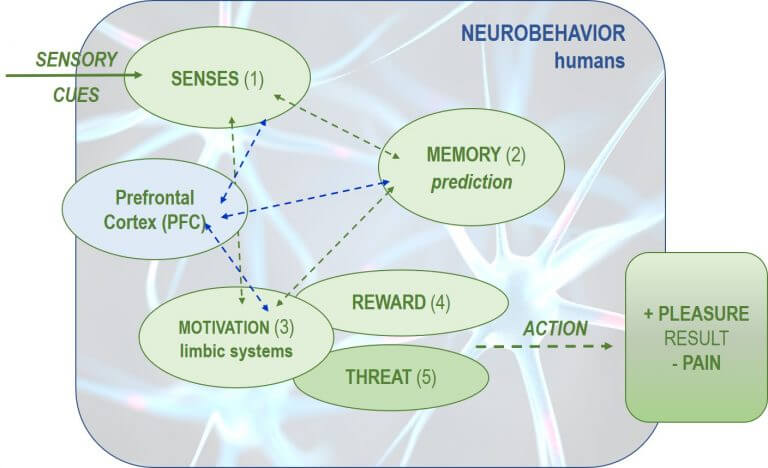
How are neurobehaviors generated and more about habits and addictions.
Neurobehaviors, habits, and addictions are created by repetition.
We will agree that a neuro behavior, whether it is motivated by the reward system (feeling pleasure) or the threat system (avoiding harm), we can call it a habit. However, we prefer to talk about neurobehaviors to be more aware that behind them there are some neural centers and connections that support them.
Habits and neurobehaviors are generated by repetition. As we use certain neural connections, they become stronger and the more they become stronger, the more we use them. This is Donald Hebb’s principle: ‘neurons that fire together wire together’.
But, to understand more about habits and addictions we will turn to Charles Duhigg’s book, The Power of Habit: Why We Do What We Do and How to Change. And to the studies by Dr Wolfram Schultz referred to by Duhigg; specifically, to Predictive Reward Signal of Dopamine Neurons.
In addictions we go into action in an impulsive way driven by the irrepressible non-conscious desire (craving) for a reward.
Dr. Schultz conducted a study with monkeys to create them, by repetition, a conditioned response to a cue. (In a before post, ‘Dopamine Fasting Technique’, we wrote about conditioning).
The monkey was presented with a certain cue on the computer screen. If the monkey pressed a lever in response to this signal, it was rewarded with a drop of fruit juice that was poured in front of its mouth.
While the monkey performed the actions, it had electrodes inserted into the brain that measured the activity of dopaminergic (which release dopamine) neurons. Remember that dopamine is the central neurotransmitter of the reward system.
In the early stages of the experiment, the activity of dopamine neurons increased when the monkey was given the juice. However, once the conditioning was created, it was enough for the monkey to observe the cue on the screen for the dopamine to be activated in its brain. The presence of the juice was not necessary, but the monkey’s brain, only with the signal that appeared in the computer, anticipated the perception of the reward stimulus. In Figure 3, we can see a diagram of the experiment.
It is very important to understand that dopamine intervenes only in the motivational phase of behavior. Dopamine does not produce pleasure; it simply activates the disposition to action.
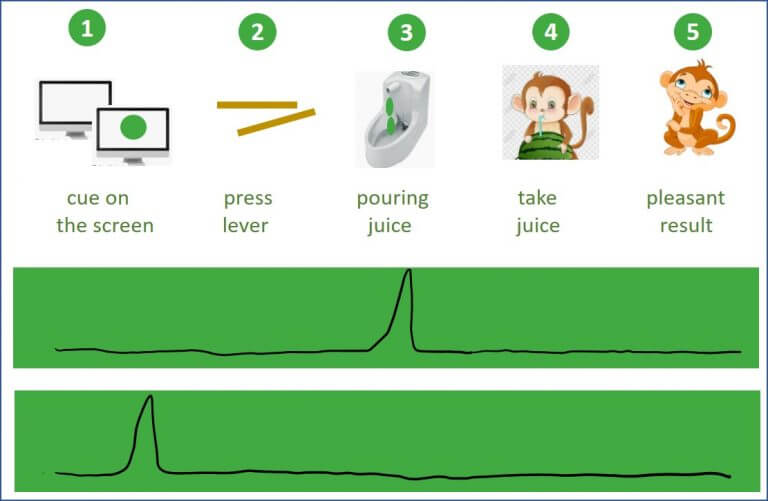
In this way, in the first stages of the process, the monkey was preparing to drink the juice when it perceived it. Instead, once the conditioning was created, the conditioned cue that initiated the neurobehavior (the signal on the computer screen) was enough for dopamine to be released in its brain and the monkey would be motivated to drink the juice, without the need for it. was presented.
This previous motivation, this irrepressible desire (craving) is what gives rise to a habit or an addiction. This is why addictions have an impulsive component and we find ourselves doing something without realizing it.
In online betting addiction, the mobile phone or computer can act as a conditioned sensory cue that triggers dopamine in the brain and the disposition to play impulsively.
It is great to have habits powered by craving that give us good results. For example, feeling an unconscious irrepressible need to persist until you find the solution to a problem. But if the results of neurobehavior are not good, then we are facing an addiction and it is not healthy to continue with it.
In online betting addiction, the presence of a signal, the mobile phone, for example, can impulsively trigger the neurobehavior of gambling. We act, impulsively, in search of a reward that in general is not such (in the medium term the betting house always wins).
We also believe that the excessive and inappropriate use of ‘screens’ (computers, mobile phones, …) favors the creation of impulsive addictions related to the difficulty in postponing the reward. We talked about it in the post ‘Impulsiveness in Education’.
Behavioral addictions and a prominent feature: Unrealistic expectations.
Gambling and online betting addictions are behavioral addictions.
In addictions we cannot stop the impulse derived from the irrepressible desire (craving) and we fall again and again into a neurobehavior that does not bring us good results. We poison ourselves. Literally, in addition, when the addiction is to substances (drugs, alcohol, …).
But we are dealing with addiction to gambling and online betting. In this case, it is not a substance addiction, but it is behavioral and has an important characteristic element: “unrealistic expectations.”
Humans pay more attention to what went well than what did not work, and we create unrealistic expectations. Then we attend to imagined and remembered sensory signals that motivate action, being able to deceive ourselves regarding the expected result. This implies a significant risk in terms of addiction to gambling and online betting.
To see it, we will refer to two articles by Sharot et al: How unrealistic optimism is maintained in the face of reality) and How Dopamine Enhances an Optimism Bias in Humans.
Sharot et al say, in the first article, that humans tend to update our beliefs in an overly optimistic biased way. We pay more attention to information about what was better than expected than what was worse. In this way, we tend to not correctly code the errors that would lead us to be more realistic and reduce optimism. Thus, optimism is linked to a selective update failure and decreased neural coding of unwanted information regarding the future.
In the second article they describe how dopamine increases this optimistic bias. Participants in one study were given L-DOPA (dihydroxy-L-Phenylalanine), a dopamine agonist. (An agonist of a neurotransmitter is a substance that acts in the same way on neuronal receptors.) They concluded that dopamine impacts belief formation by reducing negative expectations about the future.
At NeuroQuotient®, we believe that not only does dopamine reinforce positive expectations, but positive expectations generate internal cues that lead to the release of dopamine and kick-start the reward system.
It is easy to guess how unrealistic optimistic expectations will influence gambling and online betting addiction, right? We are more inclined to imagine that we are going to win than to lose and, in this way, we motivate ourselves to act without assessing the consequences.
NeuroQuotient® helps us detect the risk of gambling addiction.
The A1 dimension (Positive Imagination) of NeuroQuotient®allows us to anticipate who, and when, is most at risk of addiction to gambling and online betting.
NeuroQuotient® explains human behavior from the perspective of neuroscience. The model has 4 dimensions. Each dimension has two aspects, one that groups efficient neurobehaviors (which provide satisfactory results) and the other with limiting neurobehaviors.
A1 is the first dimension of NeuroQuotient®. The letter A indicates that it has to do with approach behaviors (Behavior Approach System). On its effective side, A1 measures the ease of launching the reward system with focus of thought. By thinking optimistically and positively, we attend to outer sensory cues or evoke (imagine or remember) inner cues that set the reward system in motion.
In addition, the A1 dimension is higher in people with greater imagination and whose thinking works faster and expresses it more spontaneity.
NeuroQuotient® dimensions have no name. If they did, we could call A1 ‘Positive Imagination’.
On the other hand, strengths and opportunities for improvement tend to be like two sides of the same coin. When someone has a high tendency for efficient A1 neurobehaviors, they may run the risk of falling into the limiting face of this dimension (A1L). That the neuro behaviors of the A1L sub-dimension are also high.
Attention! We say that risk exists, not that it is unavoidable. In fact, what we want is to facilitate awareness of this risk to reduce it as much as possible. This is related to the fact that NeuroQuotient® is not about personality, but only about behavior at a time in the person’s life. The brain has plasticity and in the same way that by repetition we create new patterns of behavior, if we stop using them, they also weaken.
In Fig 4. we can see some graphs of NeuroQuotient® highlighting dimension A1. On the left with both high subdimensions, and on the right when this limiting face is low.

Which are the neurobehaviors of the limiting side of dimension A1 of NeuroQuotient®?
We can guess that the most important neurobehaviors, in terms of the risk of falling into online gambling and online betting addictions, will have to do with an excess of ‘Positive Imagination’. With an overflowing imagination, we can:
– Have unrealistic expectations.
– Make decisions and act impulsively (letting ourselves be carried away on the spur of the moment and with difficulty postponing the reward).
-Taking unnecessary risks (by not assessing the consequences of the action).
In addition, with great imagination and fast thinking we can find:
-Scattered attention and difficulty concentrating.
-Suffering distractions.
-Excessive spontaneity in the expression of ideas.
It is not the object of the article, but we have observed that when the A1 limitation is very high, it is also likely that Attention Deficit Disorder (ADD) is present.
Temperament Character Inventory (TCI-R), NeuroQuotient® and the study quoted at the beginning (Gambling Phenotypes in Online Sports Betting).
The group at highest risk in addiction to gambling and online betting, and in the validation of NeuroQuotient® (sub-dimension A1L), stands out in the subscales ‘Impulsiveness’ and ‘Disorderliness’ of the scale ‘Novelty Seeking’ of the TCI- R.
We said at the beginning that we would return to the results of the study Gambling Phenotypes in Online Sports Betting (Bellvitge Hospital) with the Temperament and Character Inventory. We want to compare them with the ones we found in the validation process of NeuroQuotient®.
In Table I we have the correlation of A1 (efficiency) y A1L (limitations) with the Novelty Seeking scale and its subscales and the score of the highest risk group in the Bellvitge Hospital (right column).
| A1 correlation | A1L correlation | Highest risk group score | |
| Novelty Seeking | 0.38 | 0.49 | – |
| Exploratory Excitability | 0.45 | 0.26 | 1.85 |
| Impulsiveness | 0.26 | 0.46 | 3.03 |
| Extravagance | 0.16 | 0.28 | 2.65 |
| Disorderliness | 0.24 | 0.42 | 3.14 |
We see that -both in the correlation with A1L, as in the study of the risk phenotypes of addiction to online betting- the values are higher in two subscales of ‘Novelty Seeking’:
Impulsiveness and Disorderliness
Regarding to ‘Impulsiveness’ we have little to add. Online gambling addiction, so as addictions in general, have a high impulsive component.
As for ‘Disorderliness’ (summarizing Cloninger’s definition in the TCI-R), it indicates a tendency to lose their temper quickly, a low willingness to get involved in regulated activities and to follow the rules, and … difficulty in postponing the reward!
Furthermore, from the experience with NeuroQuotient®, when the A1L subdimension is high, we observe greater difficulty in learning from mistakes and structuring thinking. We believe it may be related to low concentration and the way the brain organizes temporal events (memories and imagination of the future). We saw it when dealing about ‘timeline’.
Finally, within NeuroQuotient® we have the NQ index. NQ increases with efficient neurobehaviors and decreases when limiting neurobehaviors do. This index correlates very well (> 0.60) with the Self-Directedness scale. Quite often, when the A1L limitation is high, others are too, and consequently NQ and Self-Directedness are low. This is another important coincidence with the Bellvitge Hospital study.
What can we suggest to avoid falling into the addiction to gambling and online betting and to get out of it?
We don’t want try to be expert in something we are not, but understanding the relationship between brain and behavior helps to intervene in the problems of dysfunctional behaviors.
After what was seen in the article, what could we do to reduce the problem of behavioral addictions in general and of online betting and gambling? We come up with the following:
1.Prevention at an early age.
It is very important to detect the risk early and to provide strategies for children to avoid the problem later on.
Let us try to be alert and to observe behaviors such as those we have been citing (impulsiveness, great imagination, frustration in activities that do not have a quick reward, etc.).
In this way, we can provide them with an appropriate accompaniment. We can also avoid helping to increase the problem; sometimes we do it unconsciously (see ‘Impulsiveness and Education’).
2.Prevention in adults.
In adults with higher risk, it would be very important to become aware before falling into addiction.
It is easy to say, but how do you facilitate this awareness? I wish everyone could answer NeuroQuotient®! Remember that when A1L is high or very high, the probability of being in the risk group is too.
We have an idea. NeuroQuotient®could be integrated into online sports betting platforms and define different gambling profiles (limiting the amount and frequency of bets) based on the intensity of A1L. Just when registering, users could answer NeuroQuotient® and they would be integrated into one or another profile. Even if A1L were too high, it would serve as a filter to deny access.
3.Identify external or external sensory cues that trigger the impulsive addictive neurobehavior.
It is very helpful for the person to identify the external signal that starts gambling and betting online:
What is there in my context that can act as a trigger? Cell phone? Does any image appear on it or on the computer or tv? A music?
It must also be borne in mind that the signal can be internal, generated by imagination or memory. Then:
What is my mental process before starting online betting?
It can even be other types of sensory signals, for example, feeling a certain anxiety or unease. This is more typical of substance addiction and neurobehaviors related to the fear system, but we do not rule it out in the initial exploration of online betting and gambling addiction.
Identifying the trigger for neurobehavior will serve two strategies:
The first, obviously, when once the external cue has been identified, we must try to leave it out of our reach.
The second is valid for all types of signals. By identifying the trigger we increase our awareness and we can begin to create a new and simple neurobehavior. For example: ‘count to ten’. Every time we are aware that we are facing the trigger, ‘count to ten’. This will allow us to stop the impulsive component of addiction.
4.Design and practice an alternative ‘healthy’ neuro-behavior for when the triggering signal of the addictive impulse appears.
Although we have identified the trigger, if we do not have an alternative to ‘continue’, it is difficult for us to avoid impulsive addictive behavior.
‘Count to ten’ is the simplest alternative. But it is probably too weak
However, we can go further and create a more powerful neuro-behavior based on a anchor.
The best thing is that if we practice the new neuro-behavior (we can do it visualizing), we will be creating a new conditioning to the same previous trigger cue, but good results will be derived. What previously put us in a bad situation will now lead us to a different path and to a satisfactory result.
5.Create an alternative dream or, better, an alternative ‘fear’.
This strategy is halfway between the two previous points. We have seen that the most common internal trigger in online gambling addiction has to do with unrealistic expectations, right?
How many gamblers daydream about winning or recovering what they lost?
It is a question, then, of creating a different dream, that ends badly, so that it activates fear and prudence.
Surely, this strategy will be easier to use to avoid relapses when there is already a direct experience of poor results. In the early stages of the problem, or before it occurs, the optimistic mental bias in people with unrealistic expectations makes it difficult to refute their belief that they will win at gambling and online betting.
6.Finally, an additional difficulty to take into account: Procrastination.
A common neurobehavior when A1L is high is the tendency to procrastinate. Procrastination is the habit of putting off activities that do not have an immediate reward. “I’ll find a better time to do it.”
This implies that, even if a person is aware of the bad results that derive from their addiction to gambling and online gambling, it is very likely that they tend to put off remedying it, since it requires an effort.
This tendency to procrastinate, related to low willpower, contributes to losses accumulating until the problem becomes very serious.
Well, so far strategies that we can directly imagine from what is discussed in the article. We can find more ideas and options in James Clear’s book ‘Atomic Habits. Tiny changes remarkable results’. ‘Or in the aforementioned of Charles Duggig, ‘The Power of Habit’.
Calbet. Only for English version. ?
The author’s surname, Calbet, has nothing to do with betting.
‘Calb’ in Catalan means bald, and ‘et’ is the diminutive.
So, Calbet means something as ‘little bald man’. ?

